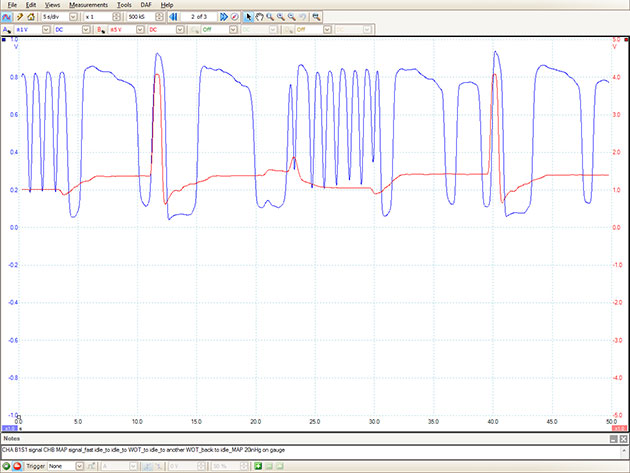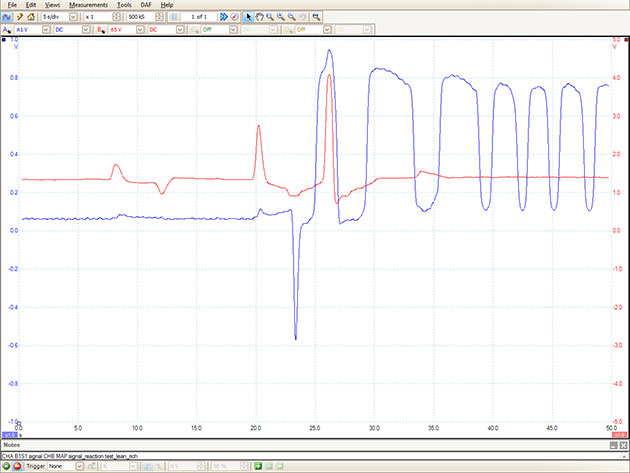
PicoScope 7 Automotive
Available for Windows, Mac, and Linux, the next evolution of our diagnostic scope software is now available.
| Vehicle details: | Rover 45 |
| Engine code: | K16 |
| Year: | 2004 |
| Symptom: | MIL on but no symptoms, P0170 |
| Author: | Rob Smith | Doncaster, South Yorkshire, UK |
This car came with the MIL (Malfunction Indicator Lamp) illuminated but no reports of any running issues.
The first action was to read the PCM (powertrain control module) for the stored code/s. There was only one stored:
P0170 - Fuel system adaptions out of range
The car was then road tested and live data via a scan tool was watched for any anomalies, one thing that stuck out was that the up-stream O2 sensor, with my foot hard to the floor on the throttle pedal, it was hitting a clean 0 V, on return from road test I put a test plan together.
I started by checking the fuel pressure, which was on spec, one thing I noticed at this point was it was still on its original fuel filter. The car was on its second owner from new and had low mileage for a 2004, so I replaced it as a matter of course.
Re-road testing after the filter change made no difference to the up-stream O2 sensor 0 V reading, I contemplated checking fuel flow at this point but decided to hook the PicoScope up and see what was occurring with the O2 signal. The reasoning for not checking fuel flow was the car never hesitated or exhibited any lack of fuel symptoms.
This was the first capture I took which shows the O2 sensor behaving normally.

After this capture I then carried out a test forcing the O2 sensor lean and rich, this is when the fault showed up.

As you can see in the above trace, Channel A (the O2 sensor) clearly drops to sub-zero readings. It was clear now that I was looking at CSD (Characteristic Shift Down).
Characteristic shift down
An oxygen sensor compares the residual oxygen content to an ambient air reference; it does this through the sensors wires. If the sensor ceramic cracks and the exhaust gas seeps through the crack the reference side becomes contaminated. The oxygen sensor then will start to work in reverse because the reference side will have less oxygen than the exhaust side therefore generating voltage in the opposite direction. This is seen as a negative voltage. The sensor can still switch as the average voltage approaches zero and continue negative. This symptom can clear up of its own accord, but if the ceramic is cracked the Characteristic Shift Down will no doubt return.
A new O2 sensor was fitted; the car was road tested and the O2 sensor behaved as normal hitting around 900 mV with the throttle on the floor.
Another case where true real time data is seen by the PicoScope compared to live data from a scan tool, as simple as this study may read and the outcome turned out, the PicoScope really gives diagnostics another dimension and I wonder without one what the next step might have been ?
Robski
April 01 2013
@Kim Anderson
Thanks for the comment.
I never looked at the fuel trims as i trusted the DTC to be telling the truth, but had i looked i would have expected the fuel trim to be maxed out as in the description of the DTC ‘Fuel system adaptions out of range’.
@Scott Thomas
Thanks for the comment.
To force a lean/rich condition add either air or propane etc into the manifold.
Thanks to all others too for your comments.
Scott Thomas
March 29 2013
Great article showing the power of using a Pico-scope and not relying just on live data. Just wondering Rob, how did you go about forcing the O2 sensor signal into the full rich / full lean modes? Regards Scott
ANGELO
March 29 2013
Good report, thankyou. I learned something new today. I was not familiar with the cracked ceramic substrate although I have witnessed negative voltages.
carlos alberto moraes
March 29 2013
Este codigo p0170 aparece muito no brasil nos carros linha citroen picasso 2.0 sempre relacionados a sonda lambda. MORAES
Kim Andersen
March 28 2013
Good job and your approach to this problem - seems straightforward.
Do you had a look at the fuel trims as well - if they were out of range. I’m asking because it would be nice know - if this type of error would be seen in the fuel trims.
washington davy masunga
March 28 2013
This was well executed,I do encourage today’s auto electricians to do a basic instrumentation and control course to understand sensor operating characteristics at varying temperatures and to interpret scantool or scope readings etc
Javier
March 28 2013
Excelente aporte, muchas gracias
Dave Hill
March 28 2013
Nice work Rob.
A great example of the need for scrutiny of the “actual” sensor values, rather than total reliance on the scantool’s data.
I am always suspicious when I see ZERO volts on a Zirconium Dioxide O2 sensor. seen on a scan tool screen & this will prompt me to follow up with a Pico.
I have to thank James Dillon for teaching me about the cracked reference chamber as the cause of this fault.
Keep up the good work Rob!